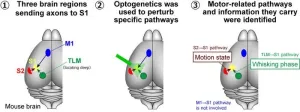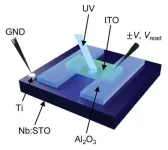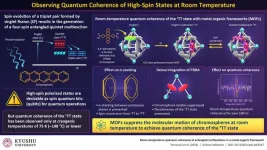(Press-News.org) Scientists have long known that some viruses and bacteria begin infections by latching first onto sugar molecules on the surfaces of cells lining the sinuses and throat of mammals, including humans. Viral particles, for instance, can attach to these molecules, called sialic acids, or SAs, like keys fitting into locks.
Now, a new study in infant mice shows that keeping virus particles from attaching to SAs limits more than just the entry of influenza A viral infections, but also hinders their exit (shedding) and transmission from mouse to mouse. Such infections are the main cause of the seasonal flu that kills more than 36,000 Americans annually. While vaccines to guard against infection and symptom treatments exist, they are not foolproof, scientists say, and more strategies are needed to prevent infection from spreading.
Led by researchers from NYU Grossman School of Medicine, the study team stripped away, or desialylated, SA receptors by placing directly into mouse nasal cavities a neuraminidase enzyme known to loosen the acids’ ability to remain attached to cell surfaces. The infant mice were then infected with influenza A. Results showed treatment with the neuraminidase enzyme dramatically cut mouse-to-mouse transmission rates by more than half (from 51% to 100% ) in a half-dozen influenza strains tested.
Publishing in the American Society for Microbiology journal mBio online Jan.11, the work was conducted in infant mice, which unlike those even a few months older or adult mice, were found by the research team to have many sialic acids in the upper portion of their respiratory tract. Specifically, the team blocked two SAs, technically called alpha-2,3 SA and alpha-2,6 SA receptors (the locks). These are known to be widely present in the human respiratory tract, which researchers say makes infant mice a strong comparable model for studying the spread of the infectious disease in children, who are also recognized as important “drivers” of flu transmission among people.
“If further experiments in humans prove successful, desialylating neuraminidase enzymes may prevent the flu from spreading,” said Ortigoza,” said lead study investigator and infectious disease specialist Mila Ortigoza, MD. PhD.
“While current approaches with vaccines and treatments target the virus, ours is the first study to demonstrate that treating the host, either infected mice or potentially infected humans, to prevent them from transmitting the virus to another host could be another effective strategy for combating pervasive infectious diseases,” said Ortigoza, who is also an assistant professor in the Departments of Medicine and Microbiology at NYU Langone.
Ortigoza cautions that extensive clinical research is needed before neuraminidases can be considered for approval as a treatment in humans. She says the team already has plans for more experiments to examine why infants are more susceptible to infection from respiratory viruses and whether blocking sialic acids in children can also prevent the spread of influenza.
Funding support for this study was provided by National Institutes of Health grants P30CA016087, S10OD021747, K08AI141759, and R01AI150893. Ansun Biopharma of San Diego, Calif., provided the experimental neuraminidase drug used in these experiments but was otherwise not involved in the study.
In addition to Ortigoza, other NYU Langone researchers involved in this study are Catherina Mobini; Hedy Rocha; Stacey Bartlett, PhD; Cynthia Loomis, MD, PhD; and Jeffrey Weiser, MD. Weiser is the Jan T. Vilcek Professor of Molecular Pathogenesis in the Department of Microbiology at NYU Langone Health and chair of the department.
Media Inquiries:
Shira Polan, on Jan. 9 and Jan. 10
212-404-4279
shira.polan@nyulangone.org
David March, from Jan. 11
212-404-3528
david.march@nyulangone.org
STUDY LINK (WILL BECOME ACTIVE AFTER EMBARGO LIFTS)
https://journals.asm.org/doi/10.1128/mbio.02203-23
END
Experiments in infant mice suggest new way to prevent spread of flu in people
2024-01-11
ELSE PRESS RELEASES FROM THIS DATE:
A universal coronavirus vaccine could save billions of dollars if ready before next pandemic
2024-01-11
What if scientists had developed a universal coronavirus vaccine in the years prior to 2020 so that it was available at the start of the COVID-19 pandemic? A universal coronavirus vaccine targets parts of the virus that are common to either many or all coronaviruses, thereby offering some degree of protection against a range of strains. A new study suggests if such a vaccine were available at the start of the pandemic, it could have saved millions of lives, prevented suffering, and saved billions of dollars in direct medical ...
Virtual Science Writers Conference will uncover the truth behind ‘hormone balancing’
2024-01-11
WASHINGTON—The popular TikTok trend of ‘hormone balancing’ has taken over the internet with claims to balance your hormones with holistic approaches alone, but medical experts question its legitimacy.
Endocrine Society expert Deena Adimoolam, M.D., will discuss ‘hormone balancing’ during the Society’s Virtual Science Writers Conference on January 24.
What: The Virtual Science Writers Conference will examine:
How hormones function and stay in balance
Common ...
Toxic algae blooms: Study assesses potential health hazards to humans
2024-01-11
Florida’s 156-mile-long Indian River Lagoon (IRL) borders five different counties and has five inlets that connect the lagoon with the Atlantic Ocean. In recent years, this estuary has experienced numerous phytoplankton bloom events due to increased seasonal temperatures coupled with environmental impacts.
Algal blooms produce a myriad of small organic molecules, many of which can be toxic to humans and animals. Among these phycotoxin producers is Microcystis aeruginosa, a freshwater cyanobacterium, which can be found in the Southern IRL. Measurable amounts of microcystins have been found in nasal swabs ...
Researchers discover potential microbiome links to skin aging
2024-01-11
The effects of aging and external factors like UV exposure on skin are well documented. As people age or spend more time in the sun, their skin tends to become drier and more wrinkled,
Recent findings have identified an exciting potential new link to signs of skin aging—the skin microbiome, the collection of microorganisms that inhabits our skin. The results come from a collaborative study carried out by researchers at the Center for Microbiome Innovation (CMI) at the University of California San Diego (UC San Diego) and L'Oréal ...
Join us in sunny San Diego for the ATS 2024 International Conference May 19-22
2024-01-11
What’s New: Register now to learn about the latest in pulmonary, critical care and sleep medicine. Join us for scientific sessions and expert interviews. Thirteen sessions will be livestreamed.
Why it matters: Stay up-to-date on subjects like COVID-19, asthma, COPD, and air pollution. We’ll assist you with conducting interviews, whether in-person or from your home office.
Contact Kevin Tuerff, ATS Communications & Marketing for more information, at ktuerff@thoracic.org END ...
Chemical Insights Research Institute commits to public health research with the opening of new laboratories
2024-01-11
ATLANTA – Chemical Insights Research Institute (CIRI) of UL Research Institutes confirmed its commitment to protecting environmental and human health when it opened its new research laboratories supporting scientific studies of environmental exposure and its societal health impact. At a ribbon cutting today, CIRI introduced the Center for Exposure Science; the Center for Toxicology and Human Health; and the Center for Advanced Measurements, each with a designated, cutting-edge laboratory.
Using the latest tools for measuring nanosized particles and parts per billion levels of chemicals and developing high-throughput cellular techniques for measuring human toxicity, ...
Challenging the traditional views on how the brain processes movement and sensation
2024-01-11
The brain is widely considered the most complex organ in the human body. The intricate mechanisms through which it processes sensory information and how this information affects and is affected by motor control have captivated neuroscientists for more than a century. Today, thanks to advanced laboratory tools and techniques, researchers can use animal models to solve this puzzle, especially in the mouse brain.
During the 20th century, experiments with anesthetized mice proved that sensory inputs primarily define neuronal activity in the primary ...
Understanding healthy and happy expectancy in former soviet countries
2024-01-11
The dissolution of the Soviet Union in 1991 marked the start of a period ripe with political, economic, and societal changes. In many former Soviet countries, these abrupt and turbulent transformations posed massive challenges to healthcare systems. Together with spikes in job losses and economic hardships, this led to a steep increase in mortality rates that would later come to be known as the “post-Soviet mortality crisis.”
However, this crisis did not affect all former Soviet countries equally. In particular, former Soviet countries in Central Asia, which include Kazakhstan, Kyrgyzstan, Tajikistan, Turkmenistan, and Uzbekistan, saw a ...
Revolutionizing real-time data processing with edge computing and reservoir technology
2024-01-11
Every day, a significant amount of data related to weather, traffic, and social media undergo real-time processing. In traditional cloud computing, this processing occurs on the cloud, raising concerns about issues such as leaks, communication delays, slow speeds, and higher power consumption. Against this backdrop, “edge computing” presents a promising alternative solution. Located near users, it aims to distribute computations, thereby reducing the load and speeding up data processing. Specifically, edge AI, which involves AI processing at the edge, is expected to find applications in, for example, self-driving ...
Generating stable qubits at room temperature
2024-01-11
Fukuoka, Japan—In a study published in Science Advances, a group of researchers led by Associate Professor Nobuhiro Yanai from Kyushu University's Faculty of Engineering, in collaboration with Associate Professor Kiyoshi Miyata from Kyushu University and Professor Yasuhiro Kobori of Kobe University, reports that they have achieved quantum coherence at room temperature: the ability of a quantum system to maintain a well-defined state over time without getting affected by surrounding disturbances
This breakthrough was made possible by embedding a chromophore, ...





